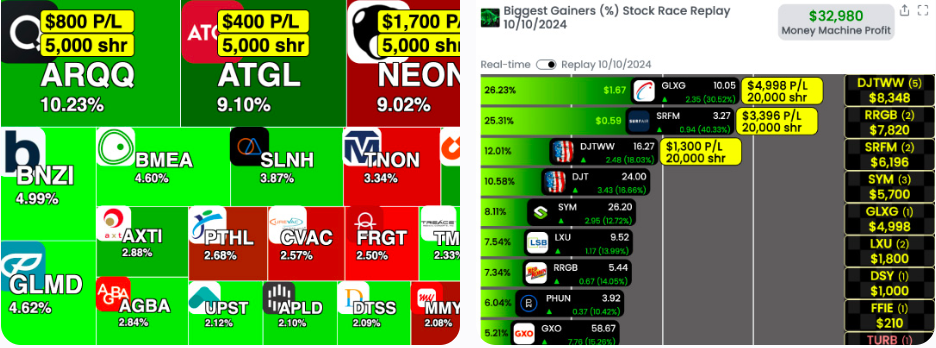20 Great Tips On Deciding On AI Stock Predictions Analysis Websites
20 Great Tips On Deciding On AI Stock Predictions Analysis Websites
Blog Article
Top 10 Tips To Customize Ai Trading Platforms To Your Strategy
AI stock-predicting/analyzing platforms offer numerous options for customization, which allow users to customize their platform to suit their individual trading goals as well as their risk tolerance and market conditions. A platform with a variety of customization features will enhance your trading. Here are 10 guidelines to evaluate the customizability of the platforms.
1. Evaluate Pre-Built Strategy Templates
Many templates. Make sure the platform comes with a wide variety of pre-built strategies for various types of trading (e.g. day trading, swing trading, or long-term investing).
You are able to easily alter the templates to adapt them to meet your particular needs.
Performance history: Determine whether the platform has historical performance data for previously-built strategies.
2. Assess the effectiveness of Custom Strategy Creation
Drag-and-drop software: Search for platforms that provide intuitive drag-and-drop interfaces to design custom strategies.
Options for Coding: For advanced users be sure to check if the platform allows custom coding using a proprietary scripting language (e.g. Python, R).
Flexibility - Make sure that the platform you choose allows you to establish rules for the entry and exit of your business, as well as parameters for risk management, as well as other essential components of your strategic plan.
3. Check for Backtesting Capabilities
Historical data. Verify whether the platform is able to supply enough historical data in order to test the strategy.
Customizable Parameters: You should be able adjust parameters, including indicators and timeframes during backtesting.
Performance metrics - Make sure to see if your software has specific indicators of performance (e.g. the winning rate, Sharpe coefficient or drawdown) for all backtested strategies.
4. Evaluate Real-Time Strategy Testing
Paper trading: Make sure the platform lets you practice or test your strategies without risking any money.
Live testing: See if you are able to test your strategies on real market conditions with small amounts of capital.
Real-time Adjustments: Test whether you're able to make adjustments in real-time, based upon market conditions.
5. Assessment of Integration using Technical Indicators
Indicator Library: Check if the platform has an indicator library that is technical (e.g. moving averages, RSI or MACD).
Custom indicators. Ensure that you are able to create or use customized indicators as part of your strategy.
Make sure the platform allows you to combine several indicators into complex strategies.
6. Check for Risk Management Tools
Stop-loss/take-profit: Ensure the platform allows you to set stop-loss and take-profit levels within your strategies.
Position sizing: Check if you can define position sizing rules (e.g., fixed amount percent of portfolio) to manage the risk.
Risk-reward ratio: Examine the support of the platform to set risk/reward ratios on specific trades or trading strategies.
7. Evaluate Multi-Asset Strategy Support
Asset classes: Make sure the platform can support strategies for various asset classes (e.g., stocks, ETFs, options and forex).
Cross-assets strategies: Discover whether you're able to create strategies that take advantage of different asset classes.
Market coverage: Make sure the platform you're interested in covers the markets you are interested in (e.g. US or international cryptocurrencies, copyright).
8. Review Automation and Execution
Automated trading - Ensure that the platform is capable of automating trading strategies based on the established rules.
Order types: Check if the platform supports various kinds of orders (e.g. market, limit and stop) for strategy execution.
Latency: Determine if the platform can make trades swiftly, particularly in high-frequency trading strategies.
9. Look for tools to optimize your strategy.
Parameter Optimization: Make sure whether the platform provides tools to optimize the parameters of strategies (e.g. genetic algorithms grid search, genetic algorithms).
Integration of machine learning: Determine whether the platform is using machine learning for refinement or optimization of strategies.
Scenario analyses: Verify whether the platform permits you to try different strategies in different market situations (e.g. bear bull, bear, volatile).
Review Community Feedback and User Feedback
User feedback: Use user feedback to evaluate the effectiveness of the platform in determining customizing strategies.
Community forums - Check for if a platform has a forum that is active and where users can share their custom strategies.
Support resources - Make sure that the platform provides tutorials and documentation to help users create and improve strategies.
Bonus Tips
Trial period: Test the customisation capabilities of the platform with a free trial or demo.
Scalability: The platform must be able to accommodate ever more complicated trading strategies as they evolve.
Customer support: Check whether you can seek assistance with strategy-related questions or issues.
Following these tips can assist you in assessing the capabilities of AI trading platforms to customize their strategies. You will be able determine which platform best suits your trading requirements and makes it possible for you to refine and implement your strategy. Platforms that have strong capabilities for customization can assist you in adapting to changing market conditions, and improve the performance of your trading. View the best ai for trading hints for website info including ai investment app, best ai trading software, ai for stock predictions, ai investment app, chart ai trading assistant, ai investment app, market ai, ai stock trading, investing ai, incite and more.
Top 10 Tips When Evaluating Ai Trading Platforms To Evaluate Their Social And Community Features
To know how users learn, interact, and share knowledge in a community, it's important to evaluate the social and community features of AI stock prediction and trade platforms. These features can enhance the user experience by providing valuable assistance. These are the top ten tips to analyze social and community aspects of these platforms.
1. Active User Group
Tips - Make sure the platform has a user base engaged in ongoing discussions, sharing insights and giving feedback.
Why: A lively community is a space where people can grow and learn together.
2. Discussion Forums, Boards
Tips: Take a look at the level of engagement and quality in message board.
Why? Forums allow users to ask questions, talk about strategies and market trends.
3. Social Media Integration
Tip Check to see if your platform integrates with other social media channels like Twitter and LinkedIn for sharing updates and insights.
Why: Social media is a great way to increase engagement and provide actual-time market data.
4. User-Generated Materials
TIP: Find features that allow users to create and share content, for example, articles, blogs, or trading strategies.
Why? User-generated content fosters collaboration and offers diverse perspectives.
5. Expert Contributions
Tip: Make sure the platform has contributions from experts in their field like AI or market analysts.
The reason: Experts' opinions add credibility and depth to discussions in the community.
6. Chat and messaging in real-time.
Tips: Make sure that users can talk to each other instantly by using real-time chat or messaging.
The reason: Real-time interaction allows rapid information exchange and collaboration.
7. Community Moderation Assistance
Tips - Check the level of moderated and support in your community.
Why: Effective moderating ensures that a respectful and positive atmosphere is maintained. user support resolves issues quickly.
8. Events and webinars
Tip: See if your platform hosts live sessions, Q&As or webinars.
The reason: These events offer the opportunity to gain knowledge and provide direct interaction with industry experts.
9. User Feedback and Reviews
Look for options that allow users to give feedback and reviews on the platform as well as the community functions it offers.
Why: User feedback helps to identify areas of strength and areas for improvement in the community ecosystem.
10. Gamification of Rewards
Tip - Check to see whether your platform supports games (e.g. leaderboards, badges) or rewards that are offered for active participation.
Gamification can be a powerful method to motivate users' involvement in the online community.
Bonus Tip Tips for Privacy and Security
Check that the community features and social features have robust privacy and security measures to guard user information and interactions.
By thoroughly assessing these aspects, you can determine whether you think the AI software for stock predictions and trading offers an active and friendly community that enhances your experience in trading and increases your knowledge. Check out the recommended click this link about best ai penny stocks for more info including ai investment tools, invest ai, best ai stocks to buy now, best ai penny stocks, stock trading ai, ai investment tools, ai options, ai software stocks, trading ai tool, ai stock prediction and more.